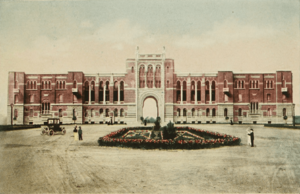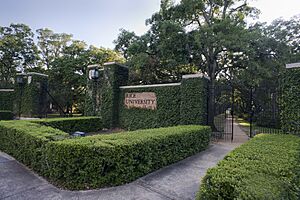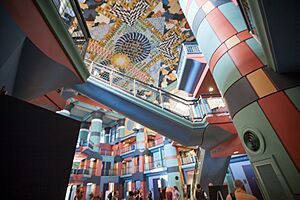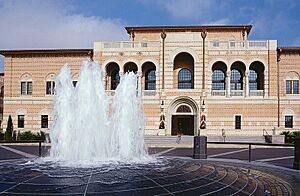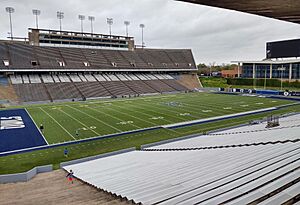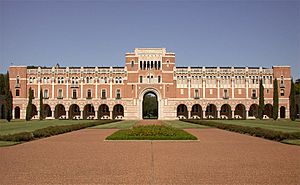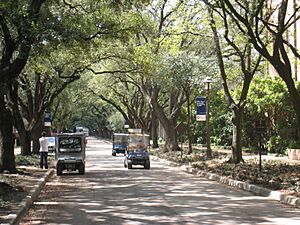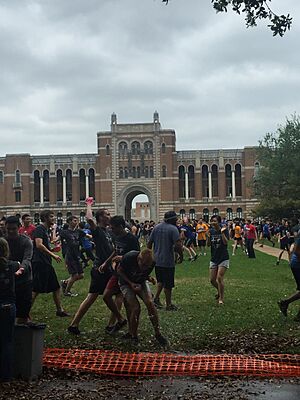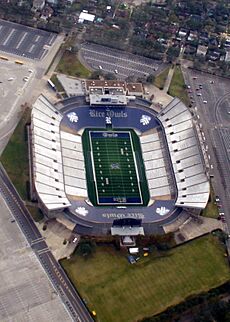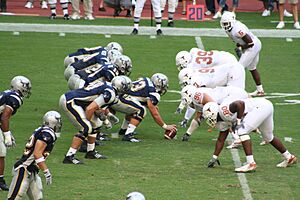Rice University facts for kids
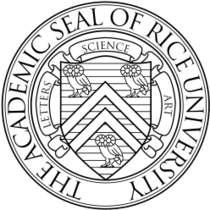 |
|
|
Former names
|
William M. Rice Institute for the Advancement of Literature, Science and Art (1912–1960) |
|---|---|
| Motto | "Letters, Science, Art" |
| Type | Private research university |
| Established | September 23, 1912 |
| Accreditation | SACS |
|
Academic affiliations
|
|
| Endowment | $7.814 billion (2021) |
| President | Reginald DesRoches |
|
Academic staff
|
855 full-time (fall 2024) |
|
Administrative staff
|
2,152 |
| Students | 8,880 (fall 2024) |
| Undergraduates | 4,776 (fall 2024) |
| Postgraduates | 4,104 (fall 2024) |
| Location |
,
Texas
,
United States
29°43′1″N 95°24′10″W / 29.71694°N 95.40278°W |
| Campus | Large city, 300 acres (120 ha) |
| Newspaper | The Rice Thresher |
| Colors |
|
| Nickname | Owls |
|
Sporting affiliations
|
NCAA Division I FBS – The American |
| Mascot | Sammy the Owl |
 |
|
William Marsh Rice University, often called Rice University, is a private research university located in Houston, Texas, United States. It was founded in 1912 and covers a large area of 300 acres.
Rice University has eight schools for undergraduate, graduate, and professional studies. These include the School of Humanities, School of Social Sciences, Jesse H. Jones Graduate School of Business, George R. Brown School of Engineering, Wiess School of Natural Sciences, Susanne M. Glasscock School of Continuing Studies, Rice School of Architecture, and Shepherd School of Music.
The university was first known as the William M. Rice Institute for the Advancement of Literature, Science and Art. It became Rice University in 1960. Since 1985, Rice has been a member of the Association of American Universities, recognized for its very high research activity. Rice teams, known as the Owls, compete in 14 NCAA Division I sports as part of the American Athletic Conference.
Many successful people have graduated from Rice. These include 26 Marshall Scholars, 13 Rhodes Scholars, 7 Churchill Scholars, and 3 Nobel laureates.
Contents
Discovering Rice University's History
How Rice University Began
The story of Rice University starts with William Marsh Rice, a businessman from Massachusetts. He made his money in Texas through real estate and railroads. In 1891, Mr. Rice decided to create a special school in Houston that would offer free education. He planned for most of his wealth to fund this project after he passed away. His will stated that the school should be "a competitive institution of the highest grade." It also specified that only white students could attend.
Mr. Rice passed away on September 23, 1900. After his death, there was a legal disagreement about his will. Thankfully, his friend and lawyer, Captain James A. Baker, helped ensure that Mr. Rice's original wish was honored. His fortune, worth about $4.6 million in 1904, was used to establish what was first called the Rice Institute.
In 1907, the university's leaders chose Edgar Odell Lovett to be the first president. President Lovett traveled the world, visiting many universities to gather ideas. He was inspired by the beautiful, uniform architecture at the University of Pennsylvania and the residential college system at Cambridge University. He wanted Rice to be a top-tier university focused on both learning and new discoveries.
Early Days and Growth
The first building, now called Lovett Hall, had its cornerstone laid in 1911. On September 23, 1912, the William Marsh Rice Institute for the Advancement of Letters, Science, and Art officially opened. It welcomed 59 students, who were sometimes called the "59 immortals," and about a dozen teachers. Eventually, the first class grew to 77 students, including both boys and girls. Rice accepted both male and female students from the very beginning.
As Mr. Rice wished, students did not pay tuition in the early years. Classes were challenging, and students worked hard. At the first graduation ceremony in 1916, 35 bachelor's degrees and one master's degree were awarded. That same year, students voted to create an Honor System, which is still a big part of academic life today. The first Ph.D. degree was given in mathematics in 1918.
In its early years, like many institutions of that time, the university had connections to racial injustice. However, Rice University has since worked to understand and address its past, striving to be a welcoming place for everyone.
In 1930, a bronze statue of William Marsh Rice was placed in the main academic area. In 2020, students asked the university to move the statue because Mr. Rice had owned enslaved people. In 2022, the university decided to relocate the statue within the campus, and it was moved in 2023. This shows how universities learn from and address their history.
During World War II, Rice Institute helped the country by joining the V-12 Navy College Training Program. This program allowed students to train for a Navy career.
The idea of residential colleges, which President Lovett had envisioned, became a reality in 1958. Existing dorms were renamed to become the first colleges: Baker, Will Rice, Hanszen, and Wiess.
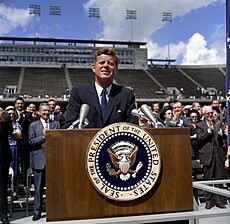
In 1959, the Rice Institute Computer started working. In 1960, the school officially changed its name to William Marsh Rice University. Rice also played a part in helping NASA get land for its Manned Spacecraft Center (now Johnson Space Center) in 1962. That year, President John F. Kennedy gave a famous speech at Rice Stadium. He challenged the United States to send a person to the Moon by the end of the 1960s. The Rice Space Institute has worked with the Johnson Space Center for over 50 years.
The original rules for Rice Institute said it should educate "white inhabitants of Houston, and the state of Texas" for free. In 1963, the university went to court to change these rules. They wanted to admit students of all races and start charging tuition. That year, Raymond Johnson became the first Black student at Rice. In 1964, Rice officially changed its rules to welcome students of all backgrounds. The university began charging tuition in 1965.
In 1974, two new schools were created: the Jesse H. Jones Graduate School of Management and the Shepherd School of Music. The Rice School of Social Sciences was founded in 1979.
For the first 40 years, only men lived in on-campus housing. In 1957, Jones College became the first women's residence. Later, Brown College was also built for women. Over time, individual colleges became coeducational, meaning both boys and girls lived there. New residential colleges like Lovett College, Sid Richardson College, and Martel College were added as the university grew.
Recent Developments at Rice
In 1990, the Economic Summit of Industrialized Nations was held at Rice. The James A. Baker III Institute for Public Policy was created in 1993. In 1997, new research centers for nanotechnology were opened. The Rice Owls baseball team achieved a national ranking of #1 for the first time in 1999.
In 2003, the Owls baseball team won their first national championship, a major achievement for the university. In 2008, President David Leebron introduced a plan called "Vision for the Second Century." This plan aimed to increase research, improve programs, and encourage teamwork. It led to new buildings like the BioScience Research Collaborative and two new residential colleges, Duncan College and McMurtry College.
In 2018, the university started an online MBA program called MBA@Rice.
In 2019, the university's president announced a task force to study Rice's past connections to slavery and racial injustice. This shows Rice's commitment to understanding its history and promoting fairness.
In 2021, the university worked with the City of Houston on a development plan for the Rice Innovation District. This plan aimed to benefit the community, though some residents hoped for a different type of agreement that would include a community group as a direct partner.
Exploring the Rice University Campus
Rice University's campus is located near West University Place in Houston's museum district. It covers about 285 acres and is filled with many trees.
The campus is surrounded by five streets: Greenbriar Street, Rice Boulevard, Sunset Boulevard, Main Street, and University Boulevard. Most of the main buildings for classes, offices, and student housing are within this original area. Some newer buildings, like graduate student housing, are just outside this main campus.
The campus is home to about 50 buildings and over 4,000 trees and shrubs, making it a beautiful place to study.
President Edgar Odell Lovett wanted all campus buildings to have a similar look. Most buildings share a Byzantine style, featuring sand and pink-colored bricks, large arches, and columns.
Lovett Hall is a famous landmark. New students walk through its Sallyport arch when they start at Rice and again when they graduate. Duncan Hall, for engineering, was designed to help different departments work together. Its unique foyer includes designs from many cultures, symbolizing teamwork.
The campus has several open areas called quadrangles. The Academic Quad features a statue of founder William Marsh Rice and includes Lovett Hall, Fondren Library, and buildings for social sciences, arts, and languages. The Humanities Building, known for its architecture, is also nearby. Further west, another quad holds McNair Hall for the Jones Business School, the Baker Institute, and Alice Pratt Brown Hall for the Shepherd School of Music. These areas are connected by a one-way road called the "inner loop." The Engineering Quad has unique sculptures and buildings for various engineering departments.
About three-quarters of Rice's undergraduate students live on campus. Housing is organized into eleven residential colleges. These colleges are named after important people in the university's history. Five colleges (McMurtry, Duncan, Martel, Jones, and Brown) are on the north side of campus. The other six (Baker, Will Rice, Lovett, Hanszen, Sid Richardson, and Wiess) are on the south side, across from the Academic Quadrangle. Baker College is the oldest, built in 1912, while Duncan and McMurtry are the newest, opened in 2009.
Rice Stadium, the on-campus football facility, opened in 1950. It can seat 47,000 people for football games. In 1962, President John F. Kennedy gave his famous "We choose to go to the Moon" speech here. The Tudor Fieldhouse is home to the basketball and volleyball teams. Other sports facilities include the Rice Track/Soccer Stadium and the Jake Hess Tennis Stadium. A new Rec Center offers an outdoor pool and exercise facilities for all students.
The Rice Innovation District
In 2019, Rice announced plans to transform the area around the old Sears building in Midtown Houston into "The Ion." This hub is part of the 16-acre South Main Innovation District. President David Leebron explained that "Ion" comes from a Greek word meaning "go," representing discovery and new ideas.
Students and community members have advocated for a Community Benefits Agreement for the Innovation District. This type of agreement would ensure that local residents also benefit from the development.
How Rice University is Organized
Rice University is a non-profit organization led by a board of trustees. This board has up to 25 members who serve four-year terms without pay. The board chooses a president to lead the university. Reginald DesRoches became president in 2022, following David W. Leebron.
The university's academic programs are divided into several schools. The Susanne M. Glasscock School of Continuing Studies offers only graduate programs. Schools with both undergraduate and graduate programs include:
- Rice University School of Architecture
- George R. Brown School of Engineering and Computing
- School of Humanities
- Shepherd School of Music
- Wiess School of Natural Sciences
- Rice University School of Social Sciences
- Jesse H. Jones Graduate School of Management
Most undergraduate students are admitted to the university as a whole, not to a specific school (except for Music and Architecture). Students can choose their major later, usually by their sophomore year. Rice offers over 360 degrees in more than 60 departments. This includes 40 undergraduate, 51 master's, and 29 doctoral programs.
Rice Management Company
The Rice Management Company handles the university's large financial fund, called an endowment, which was $8.1 billion in June 2021. This endowment provides about 40% of Rice's operating money.
In 2021, the Rice Management Company received initial approval for a development agreement. This agreement could provide up to $65 million for the Rice Innovation District from local taxes.
Academics at Rice University
Rice is a medium-sized university known for its research and on-campus living. Most students are in full-time, four-year programs focusing on arts, sciences, and professional fields. The university is highly active in research. It is officially recognized by the Southern Association of Colleges and Schools and other professional groups.
Students must take a certain number of courses from different subject areas. They also need to complete one physical education course. All new students take a Freshman Writing Intensive Seminar (FWIS) class to improve their writing skills.
Student Body at Rice
| Race and ethnicity | Total | ||
|---|---|---|---|
| White | 31% |
|
|
| Asian | 28% |
|
|
| Hispanic | 16% |
|
|
| Foreign national | 12% |
|
|
| Black | 8% |
|
|
| Other | 6% |
|
|
| Economic diversity | |||
| Low-income | 17% |
|
|
| Affluent | 83% |
|
|
In fall 2022, men made up 51.1% of undergraduate students and 63.1% of graduate students. About 36.9% of students came from outside Texas, and 27.2% were international students. Most international students in 2022 came from Asian countries, especially China, India, Taiwan, and Korea.
The Rice Honor Code
The Rice Honor Code is very important for academics. Many exams at Rice are not watched by a teacher. Instead, students take them home and complete them honestly. Any suspected cheating is reported to the student Honor Council. Students learn about the Honor System during Orientation Week. They also sign a pledge and write a statement on their assignments confirming they followed the Honor Code.
Admissions to Rice University
| 2024 | 2023 | 2022 | 2021 | 2020 | 2019 | 2018 | |
|---|---|---|---|---|---|---|---|
| Applicants | 32,473 | 31,059 | 31,443 | 29,544 | 23,455 | 27,087 | 20,923 |
| Admits | 2,597 | 2,447 | 2,730 | 2,802 | 2,555 | 2,361 | 2,328 |
| Admit rate | 8.0% | 7.9% | 8.7% | 9.5% | 10.9% | 8.7% | 11.1% |
| Enrolled | 1,148 | 1,125 | 1,203 | 1,226 | 993 | 964 | 960 |
| SAT range | 1510-1560 | 1500-1570 | 1490–1570 | 1490-1570 | 1460-1570 | 1470-1560 | 1460-1550 |
| ACT range | 34-35 | 34-36 | 34-36 | 34-35 | 34-36 | 33-35 | 33-35 |
Admission to Rice is considered "most selective" by U.S. News & World Report.
For fall 2024, Rice received 32,473 applications for freshmen, and 2,597 were admitted. This was an 8.0% acceptance rate, slightly higher than the 7.9% rate in 2023. The middle 50% of admitted students for the class of 2024 had SAT scores between 1510 and 1560. Their ACT Composite scores were between 34 and 35.
Rice practices "need-blind" admission for students from the United States. This means they consider your application without looking at your family's ability to pay tuition.
Rankings and Reputation
| ARWU World | 101–150 |
|---|---|
| THES World | =112 |
| USNWR National University | 17 |
| Washington Monthly National University | 63 |
| Forbes | 12 |
Rice was ranked tied at 17th among national universities by U.S. News & World Report in its 2022 edition. It was also ranked 6th for "best undergraduate teaching" and 5th for "Best Value." In 2024, Forbes magazine ranked Rice University 9th nationally among 500 colleges and universities.
In 2020, Rice was ranked 105th in the world by the Times Higher Education World University Rankings. QS World University Rankings placed Rice University 85th globally in 2020.
The Princeton Review recognized Rice as one of the top 50 best value private colleges in its 2020 edition.
Student Life at Rice
Rice University's 300-acre campus is in Houston's Museum District, surrounded by green spaces. It's next to Hermann Park, which has attractions like the Houston Museum of Natural Science and the Miller Outdoor Theatre. The Houston METRORail system makes it easy to get to downtown Houston. In 2008, Rice joined the Zipcar program, offering cars for students to use.
Residential Colleges
In 1957, Rice University started its residential college system, inspired by universities in England and the U.S. The existing dorms became the first colleges: Baker, Will Rice, Hanszen, and Wiess.
List of Residential Colleges
Here is a list of Rice's residential colleges, in order of when they were founded:
- Baker College, named for Captain James A. Baker, a friend of William Marsh Rice.
- Will Rice College, named for William M. Rice, Jr., the founder's nephew.
- Hanszen College, named for Harry Clay Hanszen, a university supporter.
- Wiess College, named for Harry Carothers Wiess, a founder of Humble Oil.
- Jones College, named for Mary Gibbs Jones.
- Brown College, named for Margarett Root Brown.
- Lovett College, named after the university's first president, Edgar Odell Lovett.
- Sid Richardson College, named for the Sid Richardson Foundation.
- Martel College, named for Marian and Speros P. Martel, built in 2002.
- McMurtry College, named for Rice alumni Burt and Deedee McMurtry.
- Duncan College, named for Charles Duncan, Jr., a former U.S. Secretary of Energy.
- Chao College, named after Ting Tsung and Wei Fong Chao, opened in Fall 2026.
Each residential college has its own dining hall and study groups. They also have unique traditions and "personalities." When students start at Rice, they are randomly assigned to one of these colleges. Students usually stay members of their college throughout their time at Rice, even if they move off-campus. Students are guaranteed on-campus housing for their first year and two more years. Colleges have their own systems for assigning rooms. Students feel a strong connection to their college and enjoy friendly rivalries with other colleges, especially during events like Beer Bike and Orientation Week. Colleges often play "jacks," or friendly pranks, on each other.
Beer Bike Race
Beer Bike is a fun event that combines an intramural bicycle race with a water chugging competition. It started in 1957. Each team has ten riders and ten chuggers. The rules are very detailed, even about the design of the chugging cans. Each residential college and the Graduate Student Association have men's, women's, and alumni teams. In each part of the race, a team's "chugger" must quickly drink 24 ounces of water for the men's division or 12 ounces for the women's division. Only after the chugger finishes can the team's "rider" start cycling. People who both ride and chug are called "Ironmen."
"Willy Week" is the week before Beer Bike, a time of excitement on campus. Friendly pranks are very common during Willy Week. The morning of the Beer Bike race starts with a huge water balloon fight. Beer Bike is Rice's most famous student event, and many alumni come back for it. The 2009 race was dedicated to the memory of Dr. Bill Wilson, a beloved professor.
If the weather is bad, Beer Bike becomes a Beer Run, where bikers run instead of ride.
Campus Institutions
Rice Coffeehouse
Rice Coffeehouse started in Hanszen College, where students served coffee in a study room. It later moved to a larger space. In 1990, the Rice Coffeehouse was officially founded.
The Rice Coffeehouse is a non-profit business run by students. It serves Rice University and the Houston community. It offers fair-trade and organic coffee and loose-leaf teas.
The people who work at the Coffeehouse are called K.O.C.'s, or Keepers of the Coffee. The unofficial mascot is the squirrel, often seen on merchandise. This pays tribute to Rice's friendly squirrel population.
The Pub at Rice
The Pub at Rice, formerly known as Willy's Pub, is a student-run gathering place located in the basement of the Rice Memorial Center. It opened on April 11, 1975. The original name honored the university's founder, William Marsh Rice. After a fire in 1995, the space was renovated and remains a popular spot for students to hang out. In 2022, it was rebranded as The Pub at Rice.
Rice Bikes
Rice Bikes is a full-service shop on campus where students can buy, rent, and repair bicycles. It began in the basement of Sid Richardson College in 2011. In 2012, Rice Bikes became the university's third student-run business. It moved to the Rice Memorial Center in 2014 and then to the Housing and Dining department's garage in 2017.
Student-Run Media
Rice has several student-run media groups: a weekly student newspaper (The Rice Thresher), a yearbook (The Campanile ), and a college radio station (KTRU Rice Radio). They are based in the RMC student center. Rice also has student magazines on various topics.
The Rice Thresher is published every Wednesday. It is known as one of the top campus newspapers for student readership. It covers campus news, opinions, and a satirical "Backpage." The newspaper has won several awards.
The Rice Campanile, the university yearbook, was first published in 1916. It has been published every year since then.
KTRU Rice Radio is the student-run radio station. It plays unique music and sounds not found on other Houston radio stations. KTRU takes requests and has won awards for being a top radio station. In 2010, the university sold its main FM frequency. However, KTRU continued online and returned to FM radio on 96.1 in 2015.
The Rice Review, also known as R2, is a yearly student-run literary journal. It publishes prose, poetry, and creative non-fiction by undergraduate students. It was founded in 2004.
The Rice Standard was an independent, student-run magazine that covered current events, essays, and poetry. It transitioned to an online format in 2009, featuring blog-style content for Rice students.
Rice University Athletics
Rice competes in NCAA Division I athletics and joined the American Athletic Conference in 2023. Rice was a founding member of the Southwest Conference until 1996. It then joined the Western Athletic Conference before moving to Conference USA in 2005. Rice is one of the smallest schools competing in NCAA Division I FBS football.
The Rice baseball team won the 2003 College World Series, which was the university's first national championship in a team sport. The team plays on campus at Reckling Park. As of 2010, the baseball team had won 14 conference championships in a row. They have also made six trips to Omaha for the College World Series. In 2004, Rice made history when three of its players were chosen among the first eight picks in the MLB draft.
In 2004–05, Rice sent its women's volleyball, soccer, and basketball teams to their NCAA tournaments. The women's swim team has consistently sent members to the NCAA championships since 2013. In 2011, the Women's Swim team won their first conference championship. In 2017, the women's basketball team won the Women's Basketball Invitational.
In 2006, the football team played in its first bowl game since 1961, ending a long drought. They played in the New Orleans Bowl but lost. In 2008, the football team had a great season, winning the Texas Bowl. This was the Owls' first bowl win in 45 years.
Rice Stadium is also where the university's Marching Owl Band, or "MOB," performs. The MOB is a "scatter band" that performs funny skits and routines instead of traditional marching formations.
Rice Owls men's basketball has won 10 conference titles in the former Southwest Conference. In 2007, guard Morris Almond was drafted in the first round of the 2007 NBA draft.
Rice's mascot is Sammy the Owl. In the past, the university kept live owls on campus, but this practice stopped due to concerns for animal welfare.
Rice also has a 12-member coed cheerleading squad and a coed dance team. Both perform at football and basketball games.
Notable People from Rice University
As of 2011, Rice has over 51,961 living alumni. Many students have received prestigious awards, including over 100 Fulbright Scholars, 25 Marshall Scholars, and 13 Rhodes Scholars.
Rice's faculty and alumni include five Nobel laureates, a Turing Award winner, two Pulitzer Prize winners, and many members of national academies.
In science and technology, notable alumni include:
- 14 NASA astronauts.
- Robert Curl, Nobel laureate who discovered fullerene.
- Robert Woodrow Wilson, Nobel Prize winner for discovering cosmic microwave background radiation.
- Matthew Sands, physicist and co-author of The Feynman Lectures on Physics.
- David Eagleman, neuroscientist and bestselling author.
In business and entrepreneurship, Rice alumni include:
- Thomas H. Cruikshank, former CEO of Halliburton.
- John Doerr, billionaire and venture capitalist.
- Howard Hughes, film producer and aviator.
- Brian Armstrong, founder and CEO of Coinbase.
- Burt McMurtry, a venture capitalist in Silicon Valley.
In government and politics, Rice alumni include:
- Alberto Gonzales, former U.S. Attorney General.
- Charles Duncan, former Secretary of Energy.
- William P. Hobby, Jr., former lieutenant governor of Texas.
- Josh Earnest, White House Press Secretary for President Obama.
- Glenn Youngkin, Governor of Virginia.
- Annise Parker, the 61st Mayor of Houston.
In the arts, Rice alumni include:
- Larry McMurtry, Pulitzer Prize-winning author and Oscar-winning writer.
- Joyce Carol Oates, novelist and Pulitzer Prize finalist.
- John Graves, author of Goodbye to a River.
- Caroline Shaw, Pulitzer Prize-winning musician.
In athletics, Rice alumni include: Lance Berkman, Brock Holt, Harold Solomon, Frank Ryan, Tommy Kramer, Anthony Rendon, and three Olympians.
- Notable Rice University alumni
-
James V. Allred, 33rd governor of Texas
-
Howard Hughes, aviator, engineer, industrialist, film producer and director
-
Tommy Kramer (1977), former quarterback for Minnesota Vikings
-
Annise Parker (1978), 61st Mayor of Houston
-
Alberto Gonzales (1979), former U.S. Attorney General
-
Peggy Whitson (1986), NASA astronaut
-
Josh Earnest (1997), 29th White House Press Secretary
-
Lance Berkman, professional baseball outfielder and first baseman
-
George P. Bush (1998), Commissioner of the Texas General Land Office
-
Jim Bridenstine (1998), thirteenth NASA Administrator
-
Glenn Youngkin (B.S., B.A.), Governor of Virginia
-
Stephen Hahn (1980), 24th Commissioner of Food and Drugs (2019–2021)
See also
 In Spanish: Universidad Rice para niños
In Spanish: Universidad Rice para niños



